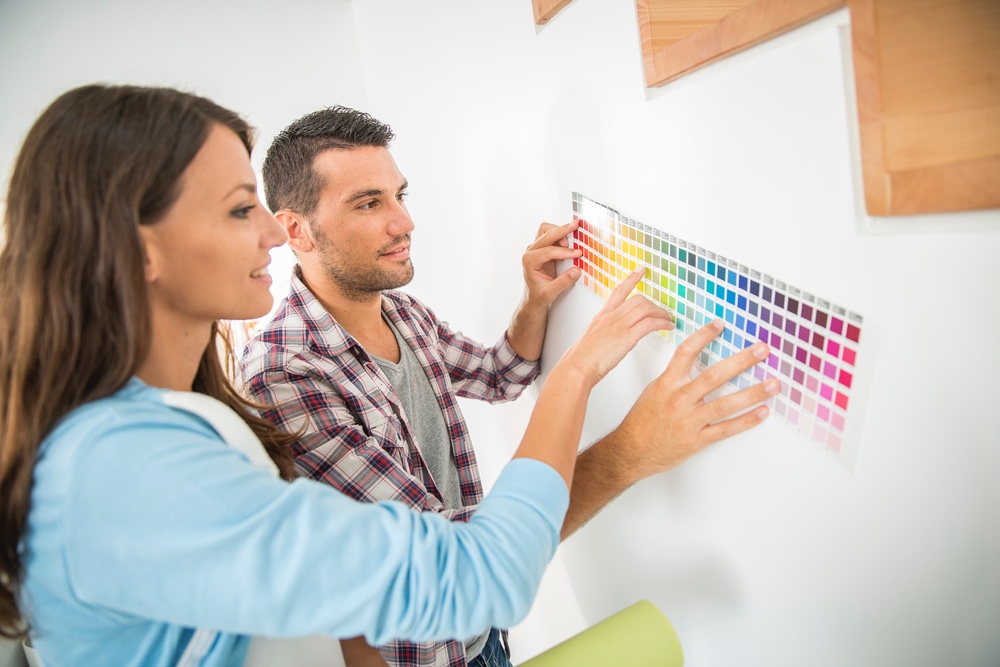The atmosphere of an Edmonton home is significantly influenced by color choices. Each hue brings its own personality, impacting the mood and overall vibe of a space. From the serenity of blues to the energy of warm yellows, understanding the psychology behind these colors can inform decisions that align with the desired ambiance.
Key Takeaways
- Understanding color psychology is essential for creating harmonious and mood-specific interior spaces.
- Lighting enhances the impact of color choices and anchors the overall mood of a room.
- Seasonal changes influence paint color preferences.
- Color scheme choices manifest differently across various home styles.
- Lastly, the utilization of color in highlighting architectural features can create a visually appealing atmosphere.
The Importance of Color Choices in Your Home
Successful interior painting involves achieving a harmonious balance of color. When painting a house, one should consider the color wheel and principles of color harmony. Contrasting colors, those sitting opposite each other on the color wheel, create a vibrant yet balanced look. On the other hand, analogous colors – colors next to each other on the wheel – create a more subtle and calming atmosphere.
The changing seasons also can profoundly affect paint color choices. Lighter, brighter colors often boost spirits in spring and summer with their fresh, airy feel. However, as autumn rolls in and winter looms, the preferences may sway towards warmer, deeper tones, fostering a snug, cozy ambiance.
Remember, a home is a mirror of its owner’s personality. It’s important to opt for colors that make one comfortable, happy, and reflective of their true selves. After all, a home should be a personal sanctuary.
Understanding the Basics of Color Psychology in Interior Design
Understanding color psychology can help create harmonious home interiors that reflect and evoke specific moods. From choosing the perfect paint for your accent wall to picking the right hues for your cabinets, harnessing the power of color can transform the aura of your home.
The Meaning of Different Colors
Color psychology studies how different shades influence emotions and behavior. For instance, red—associated with passion, love, and energy—is bold and stimulating. On the other hand, blues tend to be synonymous with calmness, serenity, and relaxation.
Yellow, a popular color in kitchen design, bathrooms, and hallways, uplifts people’s spirits, making the space feel bright and sunny. However, dull yellow hues can evoke feelings of unease. Use yellow sparingly; its optimistic effect may inadvertently stimulate negative emotions.
Popular Color Schemes for Different Home Styles
Each home has its own style, defined by its decor, architecture, and the personalities of those living within it. Here we delve into the color schemes that best complement different home styles, ranging from classic to modern, each creating its unique atmosphere.
Neutral Tones for a Timeless and Versatile Look
When it comes to interior painting, going neutral is never a dull choice. Shades like beige, taupe, grey, and white offer a timeless appeal that suits just about any home style. These colors serve as a perfect backdrop, allowing your furniture and decorative elements to take the spotlight. They are also incredibly versatile, making it easy to change up your decor over time without needing a complete house painting overhaul.
Bright and Bold Colors for a Modern and Vibrant Home
Some homeowners prefer to make a bolder statement with their decor. Bright and saturated colors can bring vibrancy and energy to a space, creating an ambiance that’s full of life. Incorporating daring tones such as deep blue and emerald green as accent colors in spaces like the living room or home office can foster an environment filled with dynamism and sophistication, as these rich colors evoke depth and rejuvenation.
Soft and Light Colors for an Elegant and Serene Ambiance
At the lighter end of the spectrum, pastel hues and lighter shades offer a gentler approach to coloring the home. These colors are ideal for creating an elegant, serene, and welcoming environment. Soft blues and greens, for instance, can enhance calmness and concentration, perfect for spaces like a bedroom or home office.
Pastel shades like terracotta or soft pink bring warmth and sociability to a space, making them a fantastic choice for living rooms. The use of light and soft colors is an effective strategy not only for the main areas of the house but also for the more hidden corners. Even a bathroom can achieve a transformative uplift with the application of an inviting shade of yellow, infusing mornings with a touch of energy and brightness.
Navigating through diverse color choices and their psychological effects continues to play a vital role in house painting and interior painting. Remember, it’s not just about aesthetics; the colors that surround you can have a profound impact on your overall well-being.
The Effect of Color on Furniture and Decor
As important as wall colors are, the influence of color doesn’t stop there. The hues chosen for furniture and decor can either complement or contrast with the wall’s color. Exciting color trends reveal a nod to the past as retro colors like mustard yellow and teal make a comeback but in more modern renditions. These colors are typically applied to accent walls, decorative accessories, or key pieces of furniture. Such shades create focal points and inject energy into the room without overpowering it.
Using Color to Highlight Architectural Features
A skilled painting contractor knows how to utilize color to draw attention to a home’s unique architectural features. Dark paint colors, when used strategically, can accentuate focal points and create a visually striking backdrop for furniture and decor. But the impact of dark paints isn’t all about aesthetics; they also possess psychological effects. Dark shades often evoke a sense of warmth and comfort, making larger rooms more inviting and smaller spaces feel snug.
Understanding these principles forms the basis of using color in interior design. Whether one is planning a house painting project, revamping their home office, or just adding some new decorative accessories, color has the power to transform any space.
The knowledge of color psychology is a powerful tool in home design, helping to stimulate positivity, promote calmness, and enhance focus. Whether you’re revamping your home office, or simply adding new decorative accessories, remember, it’s the color that holds the transformative power. So, be mindful of your color choices as they’re not just about aesthetics, they’re about creating a feel, a mood, and an atmosphere that resonates with you and your lifestyle!








